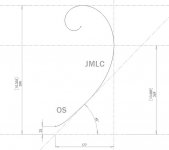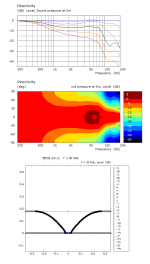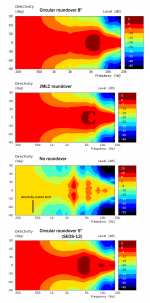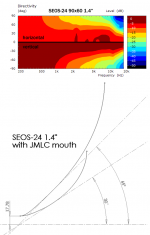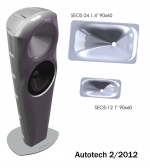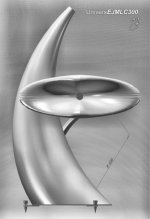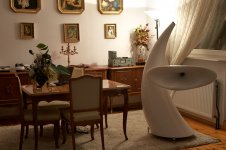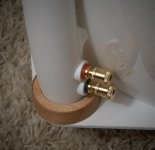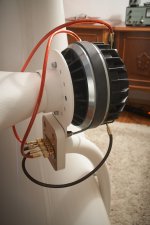Time to make a large waveguide over 20". Discussion started on AVS forum as SEOS 20" or 24" for 1.4" and 2" drivers, contour OS (oblate spheroidal) plus exponential roundover.
Hey guys...we need a little rallying here... - Page 91 - AVS Forum
Simulation of such (truncated, without rollback) with hypothetical 2" driver.
Hey guys...we need a little rallying here... - Page 91 - AVS Forum
Simulation of such (truncated, without rollback) with hypothetical 2" driver.
Attachments
Following 2" driver parameters (TAD 2001) were used for simulation:
Sd = 18,10 cm²
Cms = 1,60E-04 m/N
Mmd = 1,60 gm
Re = 6,30 ohms
Bl = 7,20 tesla.m
Rms = 2,72 newton.sec/m
Le = 0,06 millihenrys
Fs = 315hz
Qms = 1.164
Qes = 0.305
Comparison of different roundovers.
Sd = 18,10 cm²
Cms = 1,60E-04 m/N
Mmd = 1,60 gm
Re = 6,30 ohms
Bl = 7,20 tesla.m
Rms = 2,72 newton.sec/m
Le = 0,06 millihenrys
Fs = 315hz
Qms = 1.164
Qes = 0.305
Comparison of different roundovers.
Attachments
Last edited:
If anyone here has bought the mummies could you PM me a bit about how you like them and what 12" you used. I am thinking either buying them or using the oswg-12 and building my own box. I like the mummy due to the fact that I am sure it's shape will have lower diffraction then anything I would be building.
I bought the STX-equipped Mummies a year ago, and then converted to a new pair of their Beyma(12BR70)/BMS(4524) siblings last month.
(for others it may concern as well)
The STX Mummies took some time to break-in, or so I felt, and initially sported some issues with the lower mids/upper bass where some deeper voices and instruments sounded too congested and resonant. After some 6 months it was a no-issue, and what "remained" was a present, lively, coherent, and very "tight" sound. Low end was a bit lean, and rolled of quickly below 45Hz or so, but most importantly the lows were taut/agile and well defined. Mids were very present, physical, textural, and "full" - though marred at times slightly in the upper mids being a wee bit too lively. Highs were clean and effortless, if lacking a bit in extension and reverberation/differentiation. Soundstage was free of the speakers, and in all very satisfying.
The Beyma/BMS Mummies, in their present broke-in state, have an overall gentler nature, and appears the more sonically balanced of the two. Lows are more present and physical, a bit deeper, though still very taut and nimble. The mids are very well integrated with the bass(and highs), and are more firmly presented here than via the STX Mummies; the midrange seems more corehent and tightly woven to my ears, with voices sounding very realistically of-a-piece - more informative, I'd say, even though the mids are not as outwardly "expressive" as the STX Mummies. Highs are natural and effortless, as being extremely well defined and extended without calling attention to themselves. The amount of minute detail and variation they're able to retrieve from the material is very inspiring, and most be part of the reason for the very attentive overall sound where one notices the subtle inflections of a voice, etc. The soundstage is, again, free of the speakers, but with the "depth of field"(which is indeed quite impressive) more noticable here.
In all I'd call the Beyma/BMS Mummies the more precise as well as organic sounding Mummy iteration. Their rather outspoken balance lends a great insight into the variations of different recordings, and exposes contrasts in a startling fashion. They're the monitors of the two, I'd say, but perhaps not in the "usual" sense in that they always re-direct the attention to the holistic an intrinsically musical aspect.
The STX Mummies are the more outwardly sprightful of the two, and they're just extremely enjoyable to listen to: speedy, present, lively, and fun. As such I can imagine there are those who'd prefer them for this ability or even temperament of theirs, and end up combining them with a sub(or two) to get the fullness in the lows.
Not in any way to make it sound as if the Beyma/BMS Mummies are dull sounding; no way. But they're more observative, in a way, less inclined to call attention to themselves, and I find this an honest quality where one listenes through them more effectively. Conclusively I find they're the more complete sounding speakers being that they cover more material with better insight, are tonally more balanced, and are less restricted in the frequency range.
Hope the above helps a bit.
Last edited:
Does anyone have specs on the Denovo Mini Elliptical that Diy Sound sells? They look for well built and at a good price.
I'll be getting more specs up for those soon. There's nothing really "special" about them, but they do test well for their size and will work okay for smaller speakers. Another forum member has used them in a speaker set up that sounds pretty good. I've got the crossover design, just haven't had time to post it yet because of some other projects going on. There will be more designs around that model and a few other small ellipticals very soon. The smaller ones you're talking about haven't had much modifying except a different diaphragm.
But I've been working on 3 other nice compression drivers a bit more extensively trying to get them ready to go. The company that supplies the diaphragm has been pretty darn good so far in making changes as needed and I believe they're at the final stage, so I ordered the parts in the past 2 weeks. My guess is that most of the first run will sell very quickly to go with the plastic SEOS-12 that's coming soon.
That SEOS waveguide was a 100% DIY based project that jumped by leaps and bounds into a very nice set up. And with the help of another guy, we were able to put together a compression driver that should beat the DE250 in performance and price. And then an even bigger compression driver that can be crossed much lower, but still a 1". Here it is on a SEOS-18 with no crossover set up. I believe 1/24th smoothing.

Here's the big customized beast next to a DE250 model. Yeh, it's big!
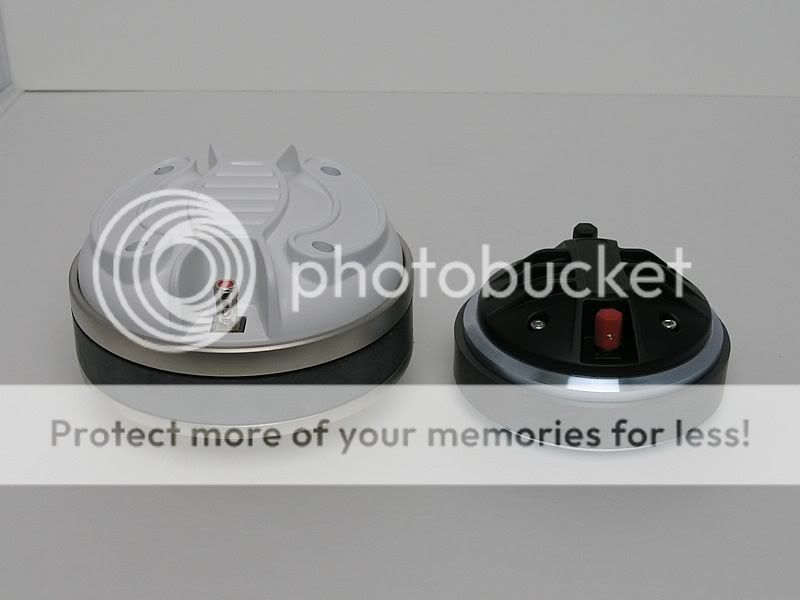
Last edited:
Thanks Erich, I already have a pretty good big system, I was just looking for a pair of tweeters I can play with. Your SEOS 18 project looks good though.
I could send you a pair if you just wanted to mess around with them. No big deal. Just let me know.
The other forum member used them with the 6" Aurasound woofer.
is anyone using these with dome tweeters? couldnt find any useful reference in this thread. i like domes, still not sold on compression drivers just yet although the numbers sure look good. i just wanted to check if there was something suitable here in smallish OB before i get some CNC from delrin. they would be mounted flush on a regular baffle similar to the summas etc, external horns arent really my taste
I could send you a pair if you just wanted to mess around with them. No big deal. Just let me know.
The other forum member used them with the 6" Aurasound woofer.
That is what I am thinking Erich. I have a number of good 6" and 8" drivers and boxes I can use. Me and a friend are trying to learn SoundEasy and we think this would be a good tweet to use. I'll PM you.
I bought the STX-equipped Mummies a year ago, and then converted to a new pair of their Beyma(12BR70)/BMS(4524) siblings last month.
(for others it may concern as well)
The STX Mummies took some time to break-in, or so I felt, and initially sported some issues with the lower mids/upper bass where some deeper voices and instruments sounded too congested and resonant. After some 6 months it was a no-issue, and what "remained" was a present, lively, coherent, and very "tight" sound. Low end was a bit lean, and rolled of quickly below 45Hz or so, but most importantly the lows were taut/agile and well defined. Mids were very present, physical, textural, and "full" - though marred at times slightly in the upper mids being a wee bit too lively. Highs were clean and effortless, if lacking a bit in extension and reverberation/differentiation. Soundstage was free of the speakers, and in all very satisfying.
The Beyma/BMS Mummies, in their present broke-in state, have an overall gentler nature, and appears the more sonically balanced of the two. Lows are more present and physical, a bit deeper, though still very taut and nimble. The mids are very well integrated with the bass(and highs), and are more firmly presented here than via the STX Mummies; the midrange seems more corehent and tightly woven to my ears, with voices sounding very realistically of-a-piece - more informative, I'd say, even though the mids are not as outwardly "expressive" as the STX Mummies. Highs are natural and effortless, as being extremely well defined and extended without calling attention to themselves. The amount of minute detail and variation they're able to retrieve from the material is very inspiring, and most be part of the reason for the very attentive overall sound where one notices the subtle inflections of a voice, etc. The soundstage is, again, free of the speakers, but with the "depth of field"(which is indeed quite impressive) more noticable here.
In all I'd call the Beyma/BMS Mummies the more precise as well as organic sounding Mummy iteration. Their rather outspoken balance lends a great insight into the variations of different recordings, and exposes contrasts in a startling fashion. They're the monitors of the two, I'd say, but perhaps not in the "usual" sense in that they always re-direct the attention to the holistic an intrinsically musical aspect.
The STX Mummies are the more outwardly sprightful of the two, and they're just extremely enjoyable to listen to: speedy, present, lively, and fun. As such I can imagine there are those who'd prefer them for this ability or even temperament of theirs, and end up combining them with a sub(or two) to get the fullness in the lows.
Not in any way to make it sound as if the Beyma/BMS Mummies are dull sounding; no way. But they're more observative, in a way, less inclined to call attention to themselves, and I find this an honest quality where one listenes through them more effectively. Conclusively I find they're the more complete sounding speakers being that they cover more material with better insight, are tonally more balanced, and are less restricted in the frequency range.
Hope the above helps a bit.
That review was exactly what I was looking for. Thank you so much for taking the time to not only tell us about the speakers but to give a compare and contrast between two different driver setup you used. Did you use the same crossover for both setups or did you make a new one for the second set of drivers? When you are pushing them a little hard can you feel the enclosure vibrate at all or are they really dead. Would you have any way to measure what the in room F3 response of your speakers are? I am curious to see just how low they go. BTW now I want a pair even more. The only thing I would change would be to modify the design the bottom to fit a 18" sub and amp, I feel like that would be the ultimate setup but I am not sure it is really needed to be honest.
Last edited:
That review was exactly what I was looking for. Thank you so much for taking the time to not only tell us about the speakers but to give a compare and contrast between two different driver setup you used. Did you use the same crossover for both setups or did you make a new one for the second set of drivers? When you are pushing them a little hard can you feel the enclosure vibrate at all or are they really dead. Would you have any way to measure what the in room F3 response of your speakers are? I am curious to see just how low they go. BTW now I want a pair even more. The only thing I would change would be to modify the design the bottom to fit a 18" sub and amp, I feel like that would be the ultimate setup but I am not sure it is really needed to be honest.
You're welcome.
Both Mummy iterations were pre-developed and -assembled, and so I had nothing to do with the "inner workings" in this regard. I only chose one and then the other based on listening impressions at my dealer. Maybe poster jzagaja can illuminate more on this, but I do know the STX Mummies use a 2nd-order filter and a x-over frequency in the vicinity of 1kHz, while the BMS/Beyma version uses a simpler x-over(fewer components) with 1.5kHz x-over frequency and 1st-order filtration(HP).
The fiberglass enclosures are very sturdy, and their (total) weight surprised me. Knocking on the surface produces an absorbing thud - being, I suppose, that the enclosures are heavily damped on the inside - but I have yet to feel for any vibrations on the surface while playing. I'll try it out once home from work.
Sadly I have no measurement equipment, but subjectively I'd say 35Hz is just within audible reach via the BMS/Beyma Mummies. In my listening room, at 15 x 14 feet, I feel no need for a sub; seeing Blu-ray films with HD-soundtracks is a powerful and fullfilling experience, and is the only way I can really get the Beyma units to move visibly. They're quite stiffly suspended. Most importantly I really dig the tightness, texture, and "slam" of the bass and how it's sonically connected upwards, and yet at the same time it's sufficiently "full." The voice of Frank Sinatra, for example, is a wonderful experience. Listening to "Spring is here" from the album Frank Sinatra Sings For Only The Lonely really showcases the clarity and physicality of the entire span of his voice over the BMS/Beyma Mummies; whether high or low in tone it's the same of-a-piece voice, something you can not take for granted even with very expensive speakers.
Very important information: the BMS/Beyma Mummies(as their siblings) require lenghty break-in, which is absolutely mandatory before making any conclusions on their sonic capabilities. That is, my pair has now played for 6 weeks, at mostly moderate volumes, and they've opened up noticably over the entire midrange(recently last weekend where they had a good workout), particularly in the lower to central mids, but also the bass has become more nimble, precise, detailed, and "connected" to the mids. The top end has become more smooth, open, and organic. Still, a friend of mine, who's very experienced with pro-style drivers for home use, tells me my Mummies have even more juice in them(following more break-in). Just so you or others don't jump to conclusions within the first hours of playing over a pair of Mummies, if you ever do, where they seem somehow reticent over much of the frequency bandwidth. Don't worry, they'll catch up.
- Home
- Group Buys
- Waveguides and horns
